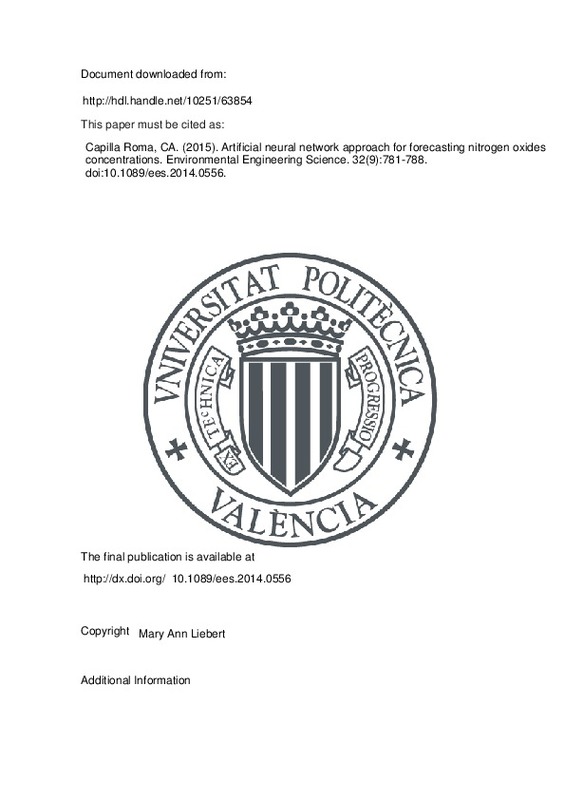JavaScript is disabled for your browser. Some features of this site may not work without it.
Buscar en RiuNet
Listar
Mi cuenta
Estadísticas
Ayuda RiuNet
Admin. UPV
Artificial neural network approach for forecasting nitrogen oxides concentrations
Mostrar el registro sencillo del ítem
Ficheros en el ítem
| dc.contributor.author | Capilla Romá, Carmen Amparo
|
es_ES |
| dc.date.accessioned | 2016-05-10T11:35:54Z | |
| dc.date.available | 2016-05-10T11:35:54Z | |
| dc.date.issued | 2015-09-01 | |
| dc.identifier.issn | 1092-8758 | |
| dc.identifier.uri | http://hdl.handle.net/10251/63854 | |
| dc.description.abstract | This paper presents the application of feed-forward multilayer perceptron networks to forecast hourly nitrogen oxides levels 24 hours in advance. Input data were meteorological variables, average hourly traffic and nitrogen oxides hourly levels. The introduction of four periodic components (sine and cosine terms for the daily and weekly cycles) was analyzed in order to improve the models prediction power. The data were measured during three years at monitoring stations in Valencia (Spain) in two locations with high traffic density. The models evaluation criteria were the mean absolute error, the root mean square error, the mean absolute percentage error, and the correlation coefficient between observations and predictions. Comparisons of multilayer perceptron-based models proved that the insertion of the four additional seasonal input variables improved the ability of obtaining more accurate predictions, which emphasizes the importance of taking into account the seasonal character of nitrogen oxides. When using seasonal components as predictors, the root mean square error (RMSE) improves from 20.29 to 19.35 when predicting nitrogen dioxide, and from 45.07 to 42.37 when forecasting nitric oxides if the model includes seasonal components At one study location. At the other location the RMSE changes from 23.76 to 23.05 when predicting nitrogen dioxide and from 33.94 to 33.10 for the other pollutant s forecasts. Neural networks did not require very exhaustive information about air pollutants, reaction mechanisms, meteorological parameters or traffic characteristics, and they had the ability of allowing nonlinear and complex relationships between very different predictor variables in an urban environment. | es_ES |
| dc.language | Inglés | es_ES |
| dc.publisher | Mary Ann Liebert | es_ES |
| dc.relation.ispartof | Environmental Engineering Science | es_ES |
| dc.rights | Reserva de todos los derechos | es_ES |
| dc.subject | Air quality | es_ES |
| dc.subject | Nitrogen oxides concentration | es_ES |
| dc.subject | Urban atmospheric pollution | es_ES |
| dc.subject | Multilayer perceptron | es_ES |
| dc.subject | Seasonal variability. | es_ES |
| dc.subject.classification | ESTADISTICA E INVESTIGACION OPERATIVA | es_ES |
| dc.title | Artificial neural network approach for forecasting nitrogen oxides concentrations | es_ES |
| dc.type | Artículo | es_ES |
| dc.identifier.doi | 10.1089/ees.2014.0556 | |
| dc.rights.accessRights | Abierto | es_ES |
| dc.contributor.affiliation | Universitat Politècnica de València. Departamento de Estadística e Investigación Operativa Aplicadas y Calidad - Departament d'Estadística i Investigació Operativa Aplicades i Qualitat | es_ES |
| dc.description.bibliographicCitation | Capilla Roma, CA. (2015). Artificial neural network approach for forecasting nitrogen oxides concentrations. Environmental Engineering Science. 32(9):781-788. doi:10.1089/ees.2014.0556 | es_ES |
| dc.description.accrualMethod | S | es_ES |
| dc.relation.publisherversion | http://dx.doi.org/ 10.1089/ees.2014.0556 | es_ES |
| dc.description.upvformatpinicio | 781 | es_ES |
| dc.description.upvformatpfin | 788 | es_ES |
| dc.type.version | info:eu-repo/semantics/publishedVersion | es_ES |
| dc.description.volume | 32 | es_ES |
| dc.description.issue | 9 | es_ES |
| dc.relation.senia | 303697 | es_ES |








